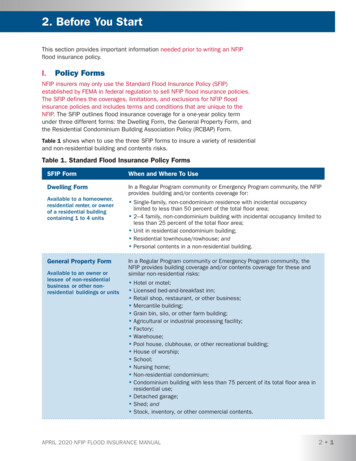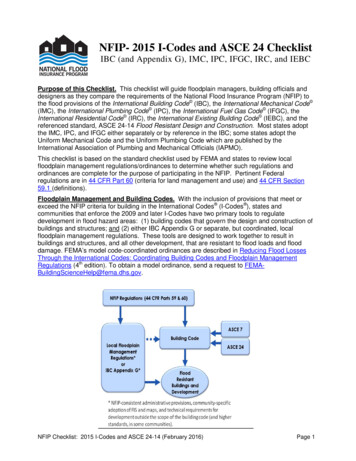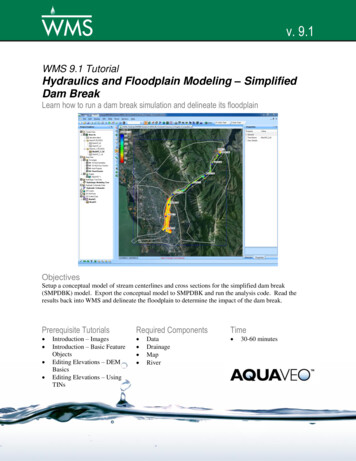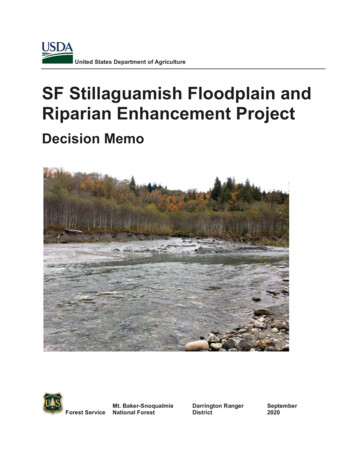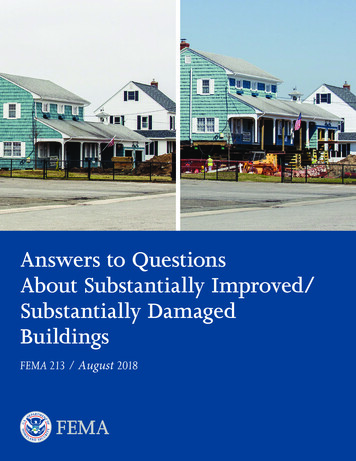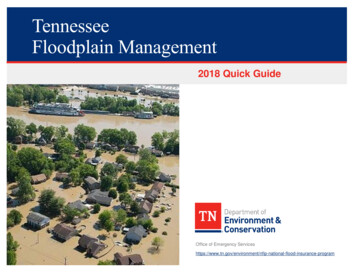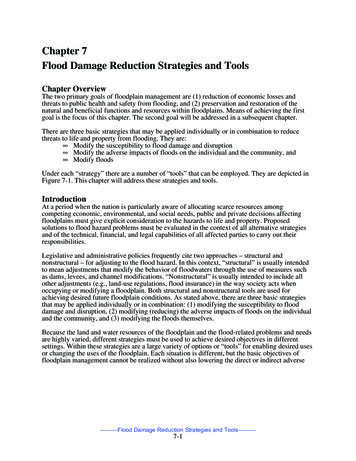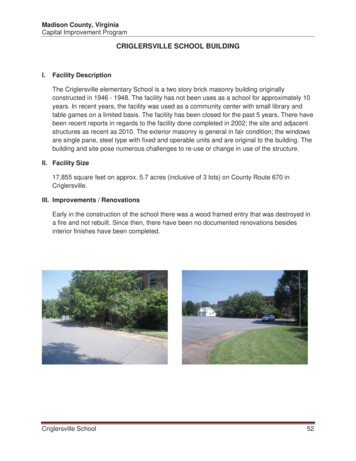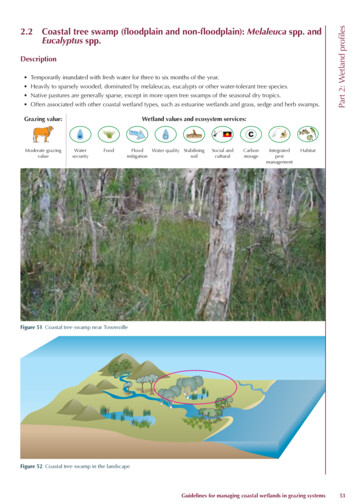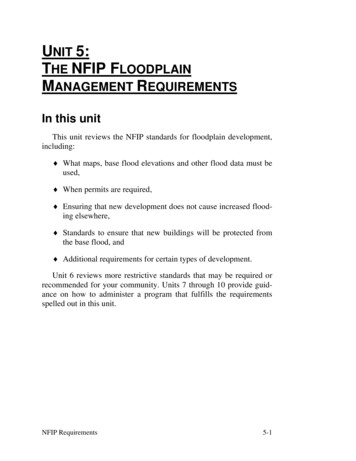
Transcription
UNIT 5:THE NFIP FLOODPLAINMANAGEMENT REQUIREMENTSIn this unitThis unit reviews the NFIP standards for floodplain development,including: What maps, base flood elevations and other flood data must beused, When permits are required, Ensuring that new development does not cause increased flooding elsewhere, Standards to ensure that new buildings will be protected fromthe base flood, and Additional requirements for certain types of development.Unit 6 reviews more restrictive standards that may be required orrecommended for your community. Units 7 through 10 provide guidance on how to administer a program that fulfills the requirementsspelled out in this unit.NFIP Requirements5-1
ContentsA. The NFIP’s Regulations. 5-4NFIP Regulations. 5-4Community Types. 5-6B. Maps and Data. 5-8NFIP Maps and Data. 5-8When FIRM and Ground Data Disagree . 5-9Regulating Approximate A Zones .10Small developments . 5-11Larger developments. 5-12Draft Revised NFIP Data . 5-14Advisory Flood Hazard Data . 5-15C. Permit Requirements . 5-17Development Permit . 5-17Building permits. 5-18Small projects. 5-18Permits from Other Agencies. 5-19D. Encroachments . 5-21Regulatory Floodways . 5-21Encroachment Review . 5-21Streams without Floodway Maps. 5-24Allowable increases in Flood Heights . 5-25E. New Buildings in A Zones Buildings. 5-27Elevation . 5-27Fill . 5-27Piles, posts, piers or columns. 5-28Walls or crawlspace . 5-29How high?. 5-31Elevation Certificate . 5-32Enclosures . 5-32Openings . 5-33Use . 5-36Floodproofing . 5-38NFIP Requirements5-2
How high?. 5-39Basements . 5-40Basement Exceptions . 5-40Basements and LOMR-F Areas . 5-41Anchoring . 5-42Flood-Resistant Material. 5-43Accessory Structures. 5-44Manufactured Homes. 5-45Elevation . 5-45Anchoring . 5-47Recreational Vehicles . 5-48AO and AH Zones . 5-49A99 and AR Zones. 5-49F. New Buildings in V Zones . 5-51Building Location . 5-51Elevation on Piles or Columns. 5-51Wind and water loads. 5-52Certification . 5-54Breakaway Walls . 5-54Coastal AE Zones . 5-56G. Other Requirements . 5-57Subdivisions. 5-57Water and Sewer Systems. 5-58Watercourse alterations. 5-58NFIP Requirements5-3
A. THE NFIP’S REGULATIONSFor a community to participate in the National Flood Insurance Program, itmust adopt and enforce floodplain management regulations that meet or exceedthe minimum NFIP standards and requirements. These standards are intended toprevent loss of life and property, as well as economic and social hardships thatresult from flooding.The NFIP standards work – as witnessed during floods in areas where buildings and other developments are in compliance with them. Nationwide each year,NFIP-based floodplain management regulations help prevent more than 1 billionin flood damages.This unit focuses on the minimum NFIP criteria. In some instances, more restrictive state standards may exist, and they must also be met by communities inthe NFIP. They are the subject of the next unit.NFIP REGULATIONSThe NFIP requirements can be found in Chapter 44 of the Code of FederalRegulations (44 CFR). Revisions to these requirements are first published in theFederal Register, a publication the Federal Government uses to disseminate rules,regulations and announcements.Most of the requirements related to your community’s ordinance are in Parts59 and 60. These are included in Appendix E along with the mapping regulationsof Parts 65 and 70.Figure 5-1 shows how the regulations are organized. The sections are referredto in shorthand, such as 44 CFR 60.1—Chapter 44, Code of Federal Regulations,Part 60, Section 1. In this course, excerpts are shown in boxes:44 CFR 59.2(b) To qualify for the sale of federally-subsidized flood insurance acommunity must adopt and submit to the Administrator as part of its application,flood plain management regulations, satisfying at a minimum the criteria set forthat Part 60 of this subchapter, designed to reduce or avoid future flood, mudslide(i.e., mudflow) or flood-related erosion damages. These regulations must includeeffective enforcement provisions.As noted in Unit 2, when your community joined the NFIP, it agreed to abideby these regulations. When your community’s FIRM was published, it had tosubmit its ordinance to FEMA to ensure that it met these requirements.NFIP Requirements5-4
Part 59—General ProvisionsSubpart A—General59.159.259.359.4DefinitionsDescription of programEmergency programReferencesSubpart B—Eligibility Requirements59.2159.2259.2359.24Purpose of subpartPrerequisites for the sale of flood insurancePriorities for the sale of flood insurance under the regular programSuspension of community eligibilityPart 60—Criteria for Land Management and UseSubpart A—Requirements for Flood Plain Management Regulations60.1 Purpose of subpart60.2 Minimum compliance with floodplain management criteria60.3 Floodplain management criteria for floodprone areas(a) When there is no floodplain map(b) When there is a map, but not flood elevations(c) When there are flood elevations(d) When there is a floodway mapped(e) When there is a map with coastal high hazard areas60.4 Floodplain management criteria for mudslide (i.e., mudflow)-prone areas60.5 Floodplain management criteria for flood-related erosion-prone areas.60.6 Variances and exceptions60.7 Revisions of criteria for floodplain management regulations60.8 DefinitionsSubpart B—Requirements for State Floodplain Management RegulationsSubpart C—Additional Considerations in Managing Flood-Prone, Mudslide (i.e.,Mudflow)-Prone, and Flood-Related Erosion-Prone AreasFigure 5-1. 44 CFR Parts 59 and 60Many state NFIP coordinators have prepared model flood damage preventionordinances to assist communities in meeting the NFIP requirements, so it is likelythat your community adopted an ordinance based on the state model.NOTE: Periodically, the NFIP regulations are revised to incorporate new requirements orclarify old ones. These changes are published in the Federal Register. Some revisionsrequire local ordinance amendments. Your community may or may not have made theamendments needed to stay updated. Before you complete this unit, you should checkwith your state NFIP coordinator or FEMA Regional Office to verify that your ordinance iscurrently in full compliance with the latest NFIP requirements.NFIP Requirements5-5
COMMUNITY TYPESNFIP regulations identify minimum requirements that communities must fulfill to join and stay in the program. The requirements that apply to a particularcommunity depend on its flood hazard and the level of detail of the data FEMAprovides to the community. The specific requirements are in Section 60.3, andapply to communities as follows: 60.3(a) FEMA has not provided any maps or data. 60.3(b) FEMA has provided a map with approximate A Zones 60.3(c) FEMA has provided a FIRM with base flood elevations 60.3(d) FEMA has provided a FIRM with base flood elevations and a mapthat shows a floodway 60.3(e) FEMA has provided a FIRM that shows coastal high hazard areas(V Zones)Two important notes:The NFIP requirements are minimums. As noted in 44 CFR 60.1(d), “Anyfloodplain management regulations adopted by a State or a community which aremore restrictive than the criteria set forth in this part are encouraged and shall takeprecedence.”These requirements are cumulative. A 60.3(c) community must comply withall appropriate requirements of sections 60.3(a) and (b). For example, 60.3(a) includes basic requirements for subdivisions and utilities that are not repeated in thelater sections. All communities in the NFIP must comply with these subdivisionand utility requirements.For example, a 60.3(c) community must use the base flood elevations provided on the FIRM. If that community has an approximate A Zone without a BFE,it must comply with the requirements of 60.3(b) for that area.The rest of this unit explores the requirements of 44 CFR 60.3. It is organizedby subject matter, so it will not correspond with the sections in 44 CFR. Whereappropriate, the specific section numbers are referenced.You should be able to identify where the requirements discussed in this unitappear in your ordinance. If you cannot find a specific reference or if you are notcomfortable with your ordinance’s regulatory language, contact your state NFIPcoordinator or FEMA Regional Office. FEMA and your state will expect you toenforce these minimum requirements as agreed to. If you don’t think your ordinance language is clear or up to date, you should consider an amendment to remove any doubt.NFIP Requirements5-6
This unit covers the minimum requirements for participation in the NFIP. Asnoted, communities are encouraged to enact regulatory standards that exceedthese minimums and that are more appropriate for local conditions.The Community Rating System (CRS) is a part of theNFIP that rewards communities that implement programsthat exceed the minimums. It is explained in more detail inUnit 9, Section C. Where provisions that can receive CRScredit are mentioned in this course, they are highlighted withthe CRS logo.NFIP Requirements5-7
B. MAPS AND DATAFlood maps and flood data were discussed in Units 3 and 4. This sectionbuilds on that information, covering the NFIP requirements as to when and how acommunity must use those maps and data.Basic rule #1: Check to make sure you have the latest flood maps and datapublished by FEMA. You must use the latest maps to administer your floodplain management ordinance.NFIP MAPS AND DATAA community must adopt and enforce floodplain management regulationsbased on data provided by FEMA (44 CFR 60.2(h)). This includes the floodplainboundaries, base flood elevations, FIRM zones and floodway boundaries shownon your current Flood Insurance Rate Map, Flood Boundary Floodway Mapand/or Flood Insurance Study.44 CFR 60.2(h): The community shall adopt and enforce flood plain management regulations based on data provided by the [Federal Insurance] Administrator. Without prior approval of the Administrator, the community shall not adoptand enforce flood plain management regulations based upon modified data reflecting natural or man-made physical changes.This requirement does not prevent a community from adopting and enforcingregulations based on data more restrictive than that provided by FEMA. For example, a community may want to regulate to an historical flood which was higherthan the BFEs shown on the FIRM. However, such data must be approved by theFEMA Regional Office before it is used.This requirement also does not prevent a community from using other technical data to identify and regulate floodprone areas not shown on FEMA maps. Forexample, many cities and urban counties map and regulate areas on small tributary streams that are not shown on the FIRM.The community always has a say in what the latest maps and data should be.FEMA will send you proposed revisions to the official FIRM and you will havetime to review them and submit your comments to FEMA before they are published. You also have a formal 90-day appeals period during which to submit yourappeals before BFEs are made final. If you disagree with the FEMA data at anytime and have scientific or technical data to support your position, you shouldsubmit a request for a map revision as noted in Unit 4, Section D, Maintainingand Revising NFIP Maps.Annexations: If a property is in a recently annexed area that does not show upon your community’s map, use the county’s map and base flood elevationsNFIP Requirements5-8
(BFEs) to determine the flood protection requirements. In fact, you should formally adopt the county’s FIRM in your ordinance to strengthen your basis forregulating areas not currently shown on your FIRM.Exceptions: The basic rule does not cover every situation. Four occasionswhere a community may vary from the effective FIRM and other data providedby FEMA are: When the FEMA data disagree with ground elevations. When the FEMA data are insufficient. This occurs in approximate AZones where base flood elevations and floodway boundaries are not provided with the FIRM. When FEMA has provided draft revised data. When FEMA provides “advisory” flood hazard data.These situations are discussed below.Note: these situations only apply to the use of flood data for floodplain management purposes. Insurance agents and lenders must use the current FIRM whendetermining insurance rates and whether flood insurance is required. If a personwants to vary from the current FIRM to obtain different premium rates or to nothave to purchase a flood insurance policy, the FIRM must be officially revised oramended.WHEN FIRM AND GROUND DATA DISAGREEThe BFEs published in the Flood Insurance Study set the level for flood protection purposes. The maps are a graphic portrayal of that information.Since FEMA usually does not have detailed topographic mapping to use inpreparing the flood maps, the flood boundaries are interpolated between cross sections using whatever topographical information is available. This can result in inaccuracies in drawing the boundaries on the map.The BFE in relation to the actual ground elevation sets the floodplain limitsfor regulatory purposes. When ground surveys show that a development site isabove the BFE, you can record the data and issue the permit. Then, if the developer or owner wants the property removed from the Special Flood Hazard Areadesignation, he or she can request a Letter of Map Amendment.It is up to them to apply for a map change, not you. The procedure is discussed in Unit 4, Section D.Conversely, if site surveys show that areas considered outside the 100-yearfloodplain on published maps are in fact below the BFE, you should require protection of new buildings to the BFE. Even though a site may be technically out-NFIP Requirements5-9
side the mapped SFHA, you are not doing future occupants any favors by ignoring the known flood hazard.REGULATING APPROXIMATE A ZONESThe second occasion where you may vary from the data provided by FEMA isin approximate A Zones. Approximate A Zones are those areas not studied by thedetailed hydrologic/hydraulic methods. These areas are shown as “unnumbered Azones” on the FIRM and “approximate 100-year flood zones” on the FloodBoundary Floodway Map. The FIS will not contain specific base flood elevationsfor approximate study areas nor will there be a floodway/fringe designation on theFBFM.44 CFR 60.3(b) When the Administrator has designated areas of special floodhazards (A zones) by the publication of a community's FHBM or FIRM, but hasneither produced water surface elevation data nor identified a floodway or coastalhigh hazard area, the community shall: (3) Require that all new subdivision proposals and other proposed developments(including proposals for manufactured home parks and subdivisions) greater than50 lots or 5 acres, whichever is the lesser, include within such proposals baseflood elevation data;(4) Obtain, review and reasonably utilize any base flood elevation and floodwaydata available from a Federal, State, or other source, including data developedpursuant to paragraph (b)(3) of this section, as criteria for requiring that new construction, substantial improvements, or other development in Zone A on thecommunity's FHBM or FIRM meet the standards Regulating development in approximate or unnumbered A Zones is one of thetougher jobs you’ll face, especially in counties that have large areas of suchzones. 44 CFR Section 60.3(b)(4) requires that you make every effort to use anyflood data available in order to achieve a reasonable measure of flood protection.Further, many states and local ordinances require a base flood elevation before apermit can be issued for any development.Here are some tips in obtaining data needed for unnumbered A Zones. Whichever method you use, be sure to record on the permit records where the flood elevation came from. This will help you be consistent with future development in thesame area. Check with your state NFIP coordinator. Some states have regulations orguidance on how to obtain regulatory data. Some have repositories of dataor may help conduct a new study. Check with local flood control, sanitary or watershed districts. Like stateagencies, they may have their own programs for developing new flooddata.NFIP Requirements5-10
If a body of water forms a boundary between two communities, the community on the other side may have a detailed study. Such base flood dataare valid for both sides of a body of water. Ask the U.S. Army Corps of Engineers, U.S. Department of Agriculture/Natural Resources Conservation Service, or U.S. Geological Survey ifthey have knowledge of any flood studies, unpublished reports, or anydata that may pertain to the area in question. If the property is along a stream that is near state highway structures suchas bridges or culverts, the state highway department may have done aflood study to properly size the structure. If the property is on a river with a power-generating dam, the dam ownermay have had to conduct a study for federal licensing. See if your engineer or the developer will conduct a study to calculateBFEs.Data obtained from one of these other sources should be used as long as they: Reasonably reflect flooding conditions expected during the base flood, Are not known to be technically incorrect, and Represent the best data available.The FEMA publication Managing Floodplain Development in ApproximateZone A Areas: A Guide for Obtaining and Developing Base (100-Year) FloodElevations provides information on a number of methodologies for developingBFEs in approximate A zones. These methodologies range from detailed methodsthat produce BFEs and perform floodway analyses similar to those developed fora Flood Insurance Study to simplified methods that can be used in isolated areaswhere more costly studies cannot be justified.If your community has approximate A Zones that are likely to be developed,you should get a copy of this document and have your engineer review it. You canalso download FEMA’s Quick-2 software for computing flood elevations fromthe FEMA flood hazard mapping website.Small developmentsIf the project is an isolated building, such as a single-family home in an undeveloped area or a subdivision or other development that does not meet the thresholds in 44 CFR Section 60.3(b)(3), you still must ensure that the building is protected from flood damages by meeting the requirements of 44 CFR 60.3(a)(3).This paragraph requires you to determine if the site is reasonably safe from flooding and, if it is not, that you ensure the building is constructed with methods andpractices that minimize flood damages and meets other construction requirements.In nearly all cases the only way to do this is to require that the building be elevated to above an elevation that you determine.NFIP Requirements5-11
There are several possible ways of establishing this elevation: Walk the site with the property owner and find a site on high ground forthe building. Sometimes by this method alone you can determine a safebuilding site or establish a safe building elevation, particularly in thefloodplain of a small stream. Sometimes detailed topographic maps areavailable that may help. Use historical records or the flood of record (the highest known flood levelfor the area). It may be that a recent flood was close to the base flood. Ifrecords of the recent flood can be used, base your regulatory flood elevations on them (or add a foot or two to the historical flood levels to providea margin of error). Before you do this, get a second opinion from yourstate NFIP coordinator, FEMA Regional Office or other agency that is familiar with the flood data you want to use. Require protection to a set elevation such as at least five feet above grade.Only use this approach if you feel confident that the five feet of elevationwill provide adequate flood protection to the building. Require the permit applicant to develop a base flood elevation or developone yourself using one of the methods in the FEMA publication ManagingFloodplain Development in Approximate Zone A Areas: A Guide for Obtaining and Developing Base (100-Year) Flood Elevations. This will usually require the services of an engineer, but will be worth the additionalexpense if it is the only way to make sure the building is protected fromflood damage. There are several methods of determining BFEs at varyingcosts and levels of detail.The first three methods are not as good as requiring protection to a BFE.However, they may be more appropriate for small isolated projects where thecosts of developing BFE information will be high relative to the cost of the building. The third approach will result in lower flood insurance rates than if the building had no protection, but the rates are not as favorable as they would be if a BFEwere calculated. Examples of the possible rates are discussed in Unit 9, Section B.Larger developmentsYou are encouraged to discuss the flood hazard as early as possible in discussions with subdividers and developers of large areas. If a subdivision or plannedunit development will be partially in the floodplain, there may be ways to avoidbuilding in the flood hazard area, which can save the developer the cost of a floodstudy.44 CFR 60.3(b)(3): [Communities must] Require that all new subdivision proposals and other proposed development (including proposals for manufacturedhome parks and subdivisions) greater than 50 lots or 5 acres, whichever is thelesser, include within such proposals BFE data.NFIP Requirements5-12
Any subdivision or other large development that meets this threshold must beevaluated to determine if the proposed site is in an approximate A Zone andwhether BFEs are required. If BFEs are required, the developer must conduct therequired study (the community, state or other agency may provide assistance).While the study must provide BFEs, you may want to require a floodway delineation and inclusion of other data needed to ensure that the building sites will bereasonably safe from flooding.BFE data are required for the affected lots in the subdivisions shown in Figure5-2 and Figure 5-3. Figure 5-2 shows a 76-lot subdivision with several lots clearlyaffected by an approximate Zone A area. The subdivision depicted in Figure 5-3is only 12 lots, but BFEs are required because the subdivision covers more thanfive acres and clearly shows buildable sites affected by an approximate Zone Aarea.Figure 5-2: Proposed 76-lot subdivisionFigure 5-3: Proposed 6.7-acre subdivisionNFIP Requirements5-13
In Figure 5-4, the entire approximate Zone A area is to be left as open space.If the planned subdivision shows the floodplain is contained entirely within anopen space lot, it may not be necessary to conduct a detailed engineering analysisto develop BFE data.Figure 5-4: Proposed 76-lot subdivision44 CFR 65.3: As soon as practicable, but not later than six months after the datesuch information becomes available, a community shall notify the Administratorof [map] changes by submitting technical or scientific data in accordance with thispart.When a developer prepares a detailed flood study in an approximate A Zone,you must submit the new flood information to FEMA within six months. Thecommunity can pass that cost on to the developer by requiring that he or she submit a request for a Letter of Map Revision as a condition of approving the development.CRS credit is provided if BFEs, floodways and related regulatory data are provided in areas not mapped by the NFIP. Thiscredit can be found in Activity 410, Section 411, of the CRSCoordinator’s Manual or the CRS Application.DRAFT REVISED NFIP DATAThe third situation where a community may vary from the official FEMA datais when FEMA has sent some preliminary data to the community for review.Communities are required to “reasonably utilize” the data from a draft or preliminary FIRM or flood insurance study.Four scenarios are possible:NFIP Requirements5-14
Where the original FIRM shows an A or V Zone with no BFEs: Use thedraft information. In the absence of other elevation or floodway data, thedraft information is presumed to be the best available. Where the original FIRM shows an AE or VE Zone with a BFE or floodway and the revision increases the BFE or widens the floodway: The draftrevised data should be used. However, if the community disagrees withthe data and intends to appeal, the existing data can be presumed to bevalid and may still be used until the appeal is resolved. Where the original FIRM shows an AE or VE Zone with a base flood elevation or floodway and the revision decreases the BFE or shrinks thefloodway: The existing data should be used. Because appeals may changethe draft data, the final BFE may be higher than the draft. If you were toallow new construction at the lower level as shown in the draft, the ownersmay have to pay higher flood insurance premiums. Where the original FIRM shows a B, C or X Zone: NFIP regulations donot require that the draft revised data be used. However, you are encouraged to use the draft data to regulate development, since these areas aresubject to a flood hazard.If the community intends to appeal preliminary data, it must be done duringthe official appeals period. Otherwise, you will have to wait for the new map tobecome official and su
UNIT 5: THE NFIP FLOODPLAIN MANAGEMENT REQUIREMENTS In this unit This unit reviews the NFIP standards for floodplain development, including: What maps, base flood elevations and other flood data must be

